Back in Canada
*No more updates to this blog, but our Flickr account will remain active.
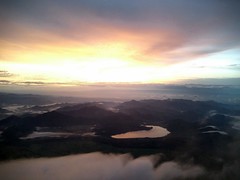
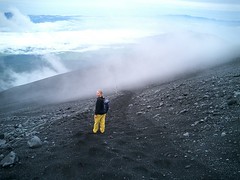
Two weeks ago we decided to visit a family bath in the Aso region of
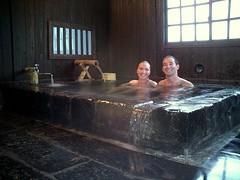
We chose a place in Oguni town Yuuka kazoku-furo 裕花 家族風呂 which has 14 baths made of stone, cut stone, and Japanese cypress. The best things about family baths are the privacy, quietness, and fresh bath water. Our bath and accompanying room was lovely. The only drawback of these baths is the time limit of 50 minutes which can seem just a tad short by the time the bath fills and you wash up. I suppose you could pay for two sessions though. If you're ever in Kumamoto, I highly recommend the Yuuka family baths.
For the past two years Eden and I have been going to a rural region of
The two small flooded, muddy fields we planted we’re alive with leeches, larvae and frogs. It wasn’t the easiest thing to ease into, but luckily the leeches didn’t bite. All in all I’m not sure if it’s something that I’d choose to do again but am glad that we did it once. The poor old men and women who’ve done this there entire lives are bent over with their backs nearly horizontal, partly due to the hard work and I think partly due to a lack of calcium (traditionally Japanese people don’t consume dairy products, they get all their calcium from fish bones).
Yesterday, for the first time ever, I was caught speeding. On my commute home from school it is impossible to go faster than the limit of 40 or 50 kph in all but one place, and that’s just where I was caught. For most of my drive the roads are too narrow, windy, crowded or have too many stops to touch above 50 kph for more than a few seconds, but traffic clears up nicely when the road crosses the river and follows an overpass avoiding the intersection below. On this particular section, 50 kph seems like a crawl and everyone pushes their car to at least 60 kph. As I was descending the overpass, picking up a little speed, two men ran in front of my car waving large red flags. Not expecting someone to dash in front of a speeding car, I slammed on my brakes and swerved to avoid them. They then gestured for me to pull over and asked if I was in a hurry because I was speeding. I always think it’s unfair to point the radar gun at people descending a hill or something, but considering I was driving 76 kph in a 50 kph zone, I had little excuse. What really did irk me was the stiffness of the fine, 18,000 yen or around $220 CDN, and the fact that people don’t get in trouble for running red lights or watching TV while driving; two very common driving habits in Japan that I would consider much more dangerous.
I suppose though that the fine did serve its purpose. It has made me slow down to the speed limit (or just a little over) and I suppose this makes things safer for myself and the public.
North of Hita station is an area called "Mameda" 豆田. It has been kept quite traditional with a number of nice, well-worn, old buildings. Having visited Uchiko内子, in Shikoku the week before, Hita seemed a little less special, but it does have the finest old street I have found in Kyushu. (Yanagawa 柳川and its canals are just as pleasant, but there are fewer old buildings.)
On my search for the ideal geta I found a few interesting pair. One was a duel support stilt geta which would make me about five inches taller. Another was a single support stilt geta which would prove rather difficult to walk in. The third interesting pair had a very round arch, almost semicircular. At last, I did find a pair which appealed to me, (dark wood, wide, rectangular, dark strap and with a short, dual support so that the clog rocks when you walk) only to find out that they were just too small. Eden, who is less particular than me when it comes to geta was able to find a lovely pair for only 1100 yen, about $13 CND.
Currently listening to: Pearl Jam - Ten
Eden is reading: Cry, the Beloved Country - Alan Paton
Josh is reading: The Hanging Garden - Ian Rankin
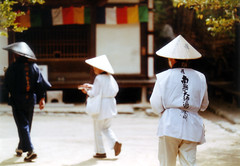
1. Spend a night a Chiiori.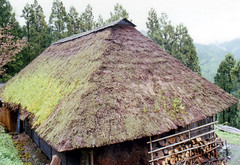 If you have the time, and are able to make it to the somewhat remote Iya Valley 祖谷, I highly recommend spending a night or more at Chiiori. Chiiori is a traditional thatched-roof farm house near Miune-san 三嶺山 in Higashi-Iya 東祖谷 village. It is maintained by a group of volunteers, and is more of a private residence or cooperative than a hotel. There are various work weekends throughout the year where you can help cut thatch for a new roof, help garden, or other work needed to keep the 300-year old structure standing. All guests sleep in the main hall on futons. Normally a Japanese house such as this would be partitioned into a few smaller rooms, but when Alex Kerr bought the place thirty years ago, he removed them to bring more sunlight into the rest of the house. Still, it is quite dark inside and adds to the romance of the place. Sitting around the hearth drinking tea, smoke billowing up to the rafters, rain and mist obscuring the trees and mountains was a wonderful experience.
If you have the time, and are able to make it to the somewhat remote Iya Valley 祖谷, I highly recommend spending a night or more at Chiiori. Chiiori is a traditional thatched-roof farm house near Miune-san 三嶺山 in Higashi-Iya 東祖谷 village. It is maintained by a group of volunteers, and is more of a private residence or cooperative than a hotel. There are various work weekends throughout the year where you can help cut thatch for a new roof, help garden, or other work needed to keep the 300-year old structure standing. All guests sleep in the main hall on futons. Normally a Japanese house such as this would be partitioned into a few smaller rooms, but when Alex Kerr bought the place thirty years ago, he removed them to bring more sunlight into the rest of the house. Still, it is quite dark inside and adds to the romance of the place. Sitting around the hearth drinking tea, smoke billowing up to the rafters, rain and mist obscuring the trees and mountains was a wonderful experience.
2. Dogo onsen 道後温泉. Not the most relaxing bath in
3. Shin-Iya-Onsen, Kazura-bashi Hotel 新祖谷温泉 かずら橋ホテル. This lovely onsen has to rate as one of my favourites. It is newer than the other baths in the
4. Oku-Iya Kazura-bashi (Vine Bridges)奥祖谷かずら橋. 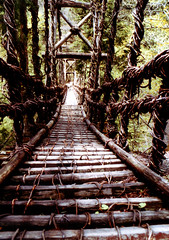 No trip to the
No trip to the
5. Iya-kei祖谷渓. The actual Iya gorge is deep, natural, and beautiful. However, due to the roads, houses, and other construction it lacks the mystical feeling apparent in Yakushima (especially in the early morning mist around Miyanoura-dake). It is easy to imagine how the area must have been, and how inaccessible it was when the Heike warriors fled here. Wild, isolated, lost
6. Hiking from Tsurugi-san剣山 to Miune-san 三嶺山. 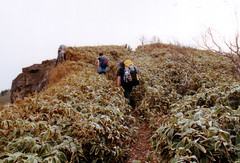 Tsurugi-san is a sacred mountain in
Tsurugi-san is a sacred mountain in
7. Shimanto-gawa 四万十川. 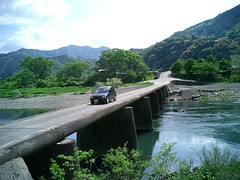 The last free flowing river in
The last free flowing river in
8. Uchiko 内子. 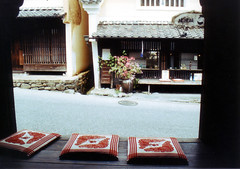 This small city in Ehime prefecture is a nice place to spend a few hours. The old merchant street with late
This small city in Ehime prefecture is a nice place to spend a few hours. The old merchant street with late
Currently listening to: Pearl Jam - Ten
Eden is reading: Angels and Demons - Dan Brown
Josh is reading: The Da Vinci Code - Dan Brown
